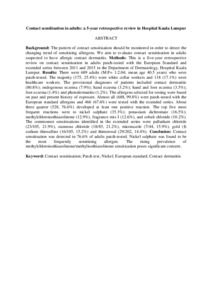Citation
How, Kang Nien and Tang, Min Moon and Jagjit Singh, Roshnee Kaur and Johar, Asmah
(2017)
Contact sensitisation in adults: a 5-year retrospective review in Hospital Kuala Lumpur.
Medical Journal of Malaysia, 72 (2).
113 - 118.
ISSN 0300-5283
Abstract
Background: The pattern of contact sensitisation should be monitored in order to detect the changing trend of sensitising allergens. We aim to evaluate contact sensitisation in adults suspected to have allergic contact dermatitis. Methods: This is a five-year retrospective review on contact sensitisation in adults patch-tested with the European Standard and extended series between 2011 and 2015 in the Department of Dermatology, Hospital Kuala Lumpur. Results: There were 689 adults (M:F= 1:2.04; mean age 40.5 years) who were patch-tested. The majority (175, 25.4%) were white collar workers and 118 (17.1%) were healthcare workers. The provisional diagnoses of patients included contact dermatitis (80.8%); endogenous eczema (7.9%); hand eczema (3.2%); hand and foot eczema (3.5%); foot eczema (1.4%) and photodermatitis (1.2%). The allergens selected for testing were based on past and present history of exposure. Almost all (688, 99.8%) were patch-tested with the European standard allergens and 466 (67.6%) were tested with the extended series. About three quarter (528, 76.6%) developed at least one positive reaction. The top five most frequent reactions were to nickel sulphate (35.3%); potassium dichromate (16.5%); methylchloroisothiazolinone (12.9%), fragrance mix I (12.6%), and cobalt chloride (10.2%). The commonest sensitisations identified in the extended series were palladium chloride (23/105, 21.9%), stannous chloride (18/85, 21.2%), miconazole (7/44, 15.9%), gold(I)sodium thiosulfate (16/105, 15.2%) and thimerosal (29/202, 14.4%). Conclusion: Contact sensitisation was detected in 76.6% of adults patch-tested. Nickel sulphate was found to be the most frequently sensitising allergen. The rising prevalence of methylchloroisothiazolinone/methylisothiazolinone sensitization poses significant concern.
Download File
![[img]](http://psasir.upm.edu.my/61218/1.hassmallThumbnailVersion/Contact%20sensitisation%20in%20adults%20a%205-year%20retrospective%20review%20in%20Hospital%20Kuala%20Lumpur.pdf)  Preview |
|
Text (Abstract)
Contact sensitisation in adults a 5-year retrospective review in Hospital Kuala Lumpur.pdf
Download (6kB)
| Preview
|
|
Additional Metadata
Actions (login required)
 |
View Item |

